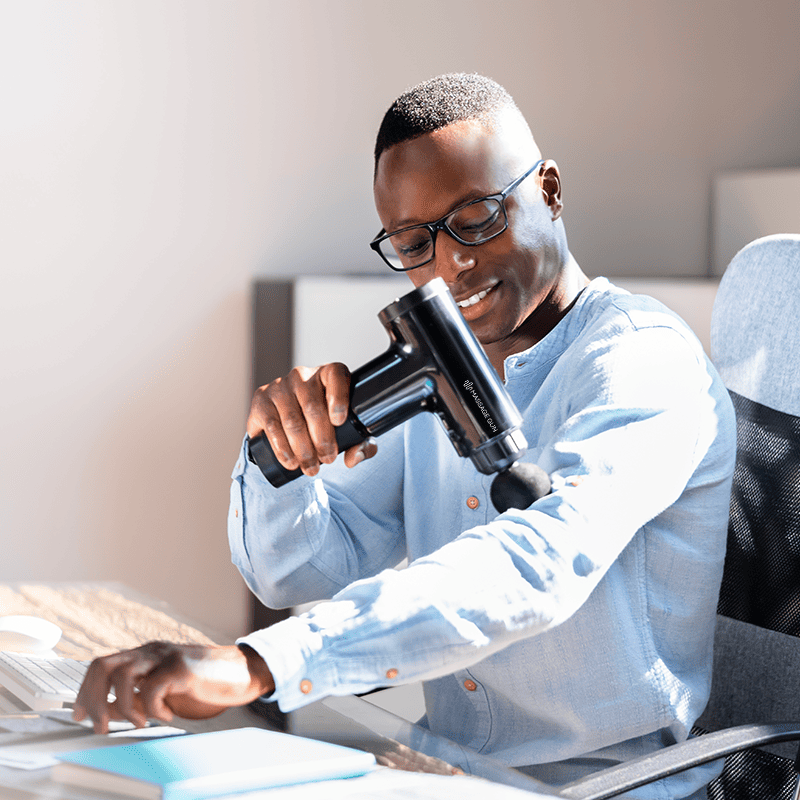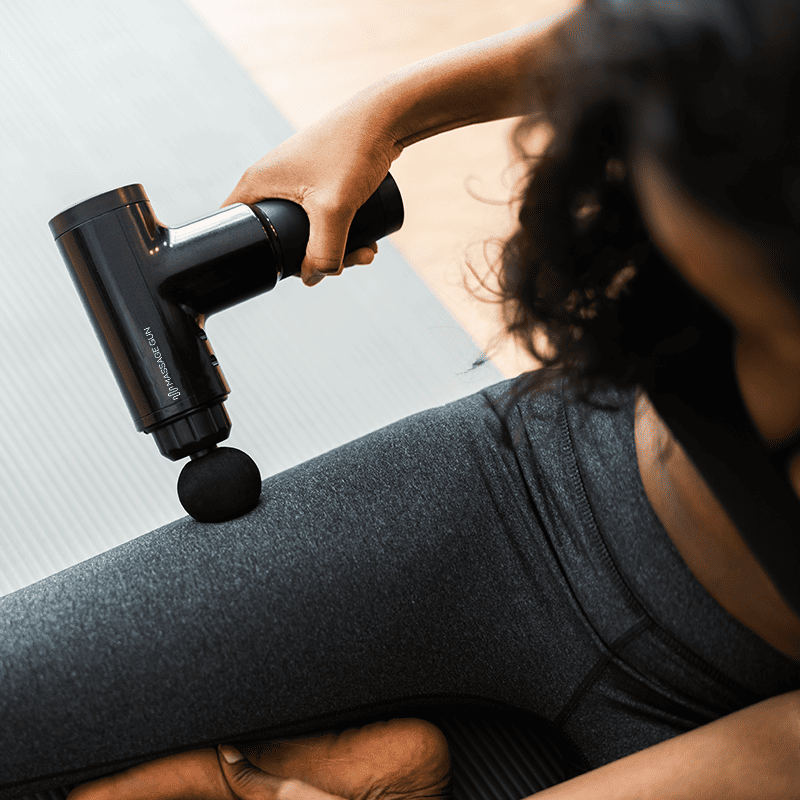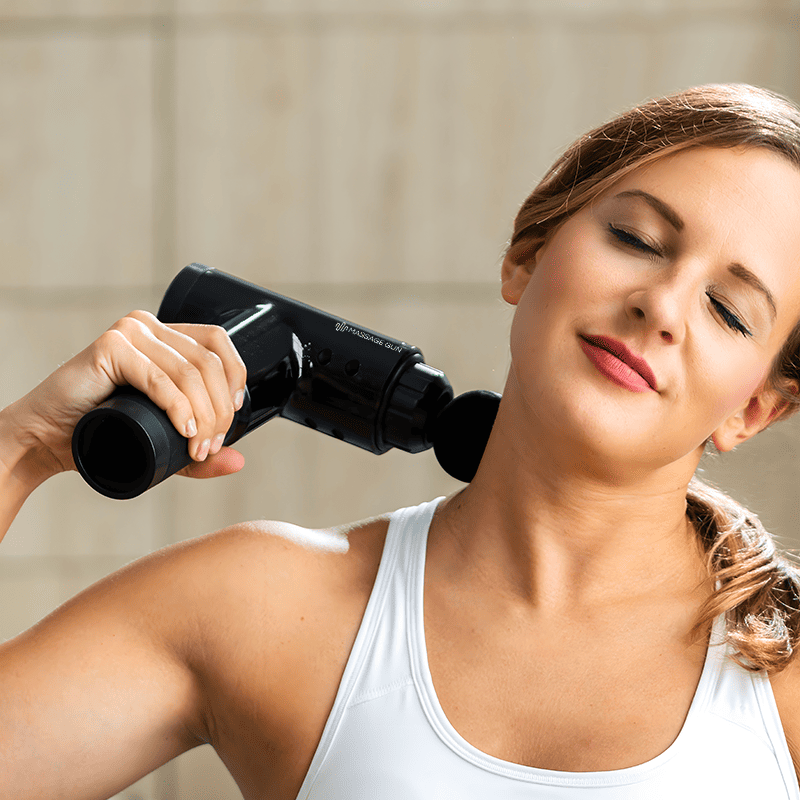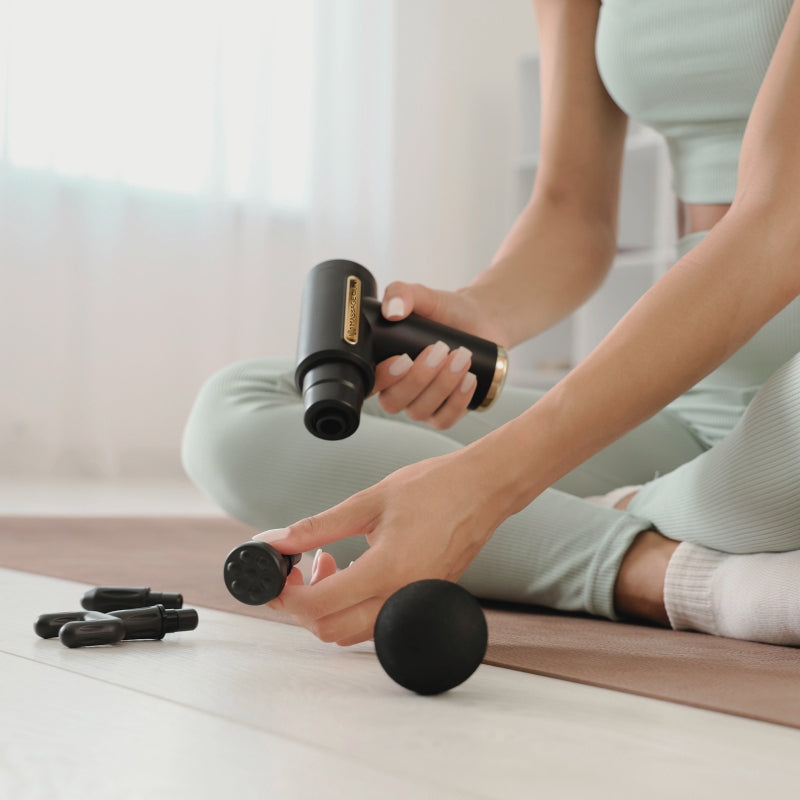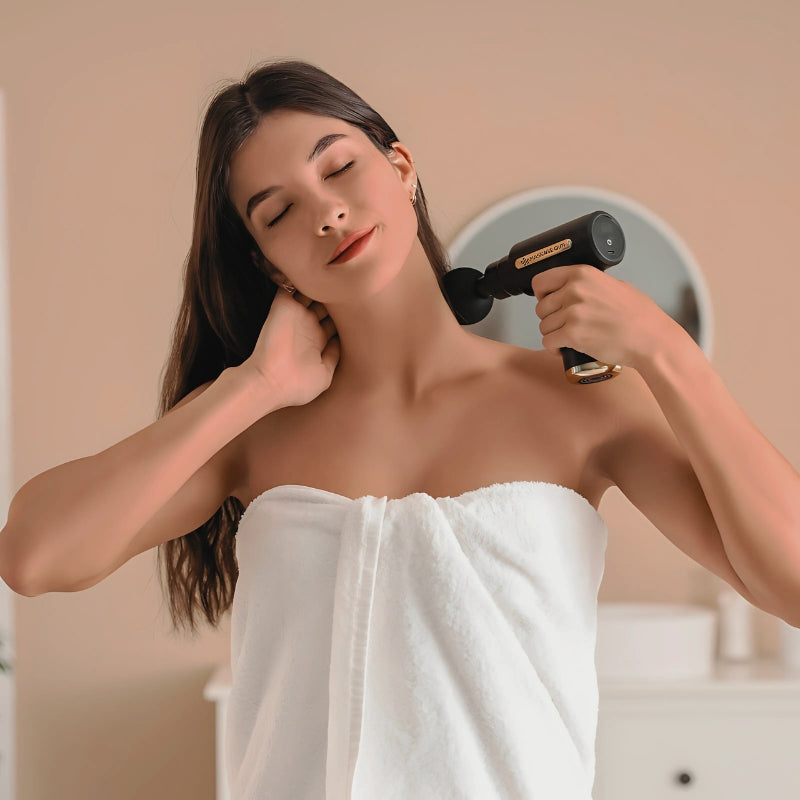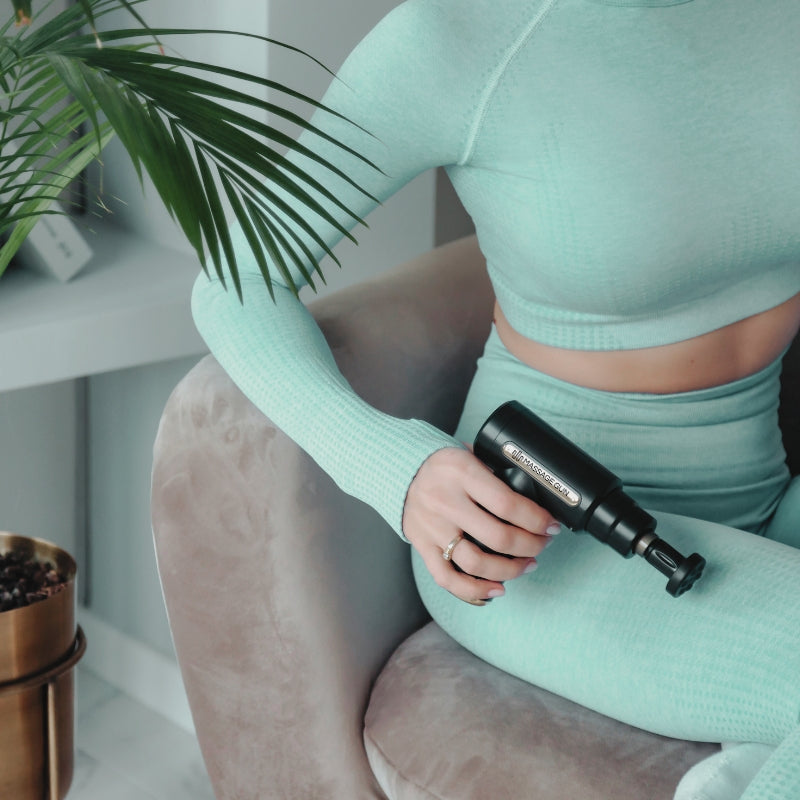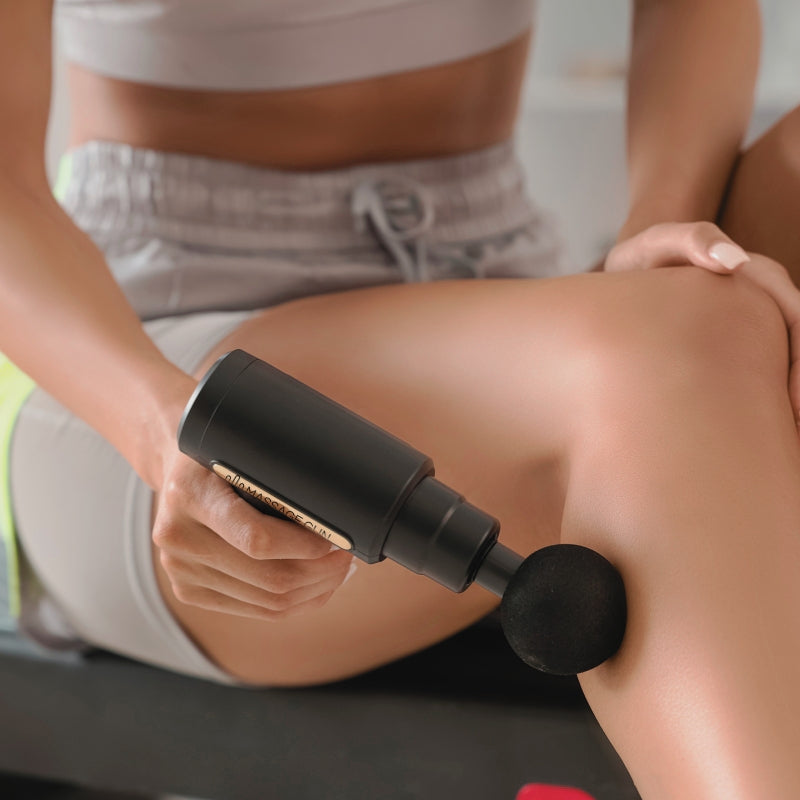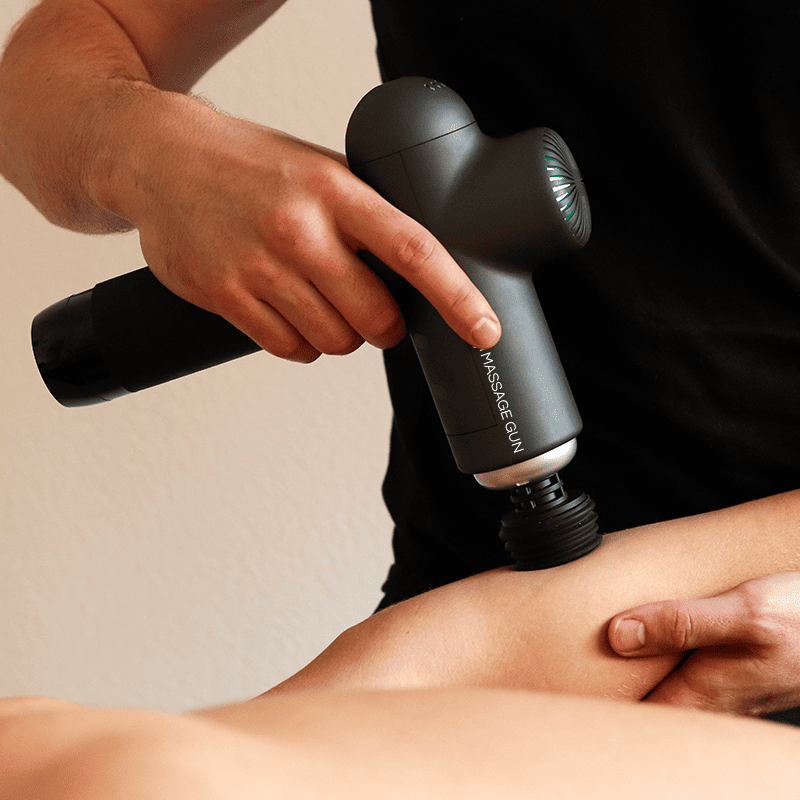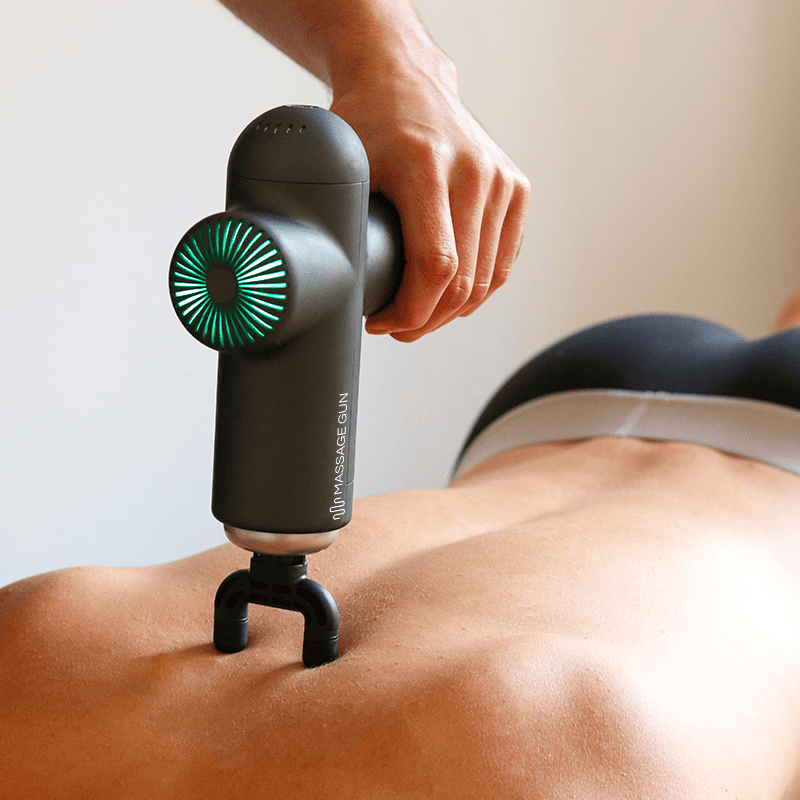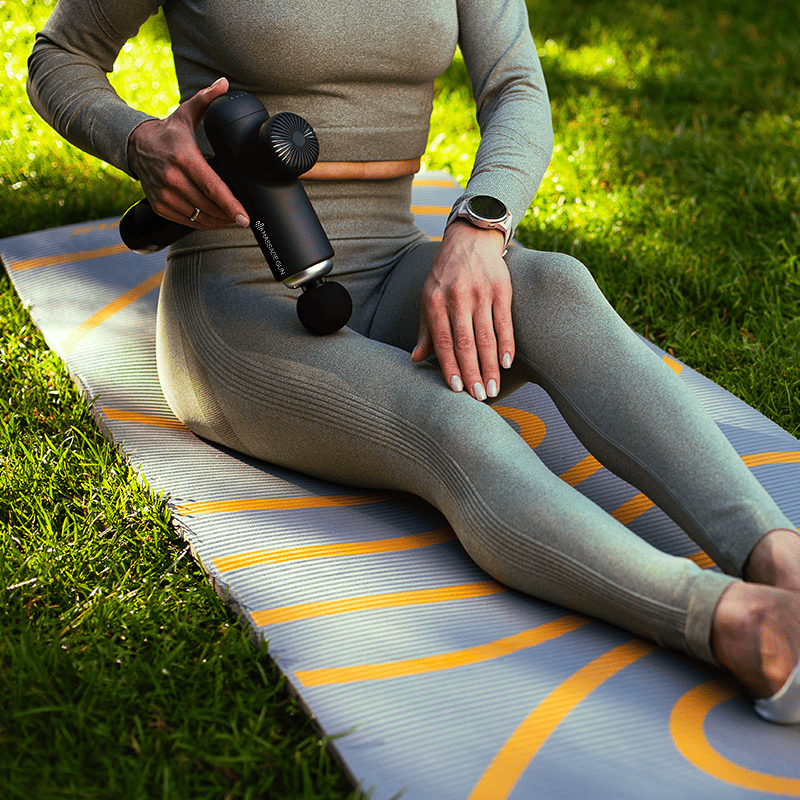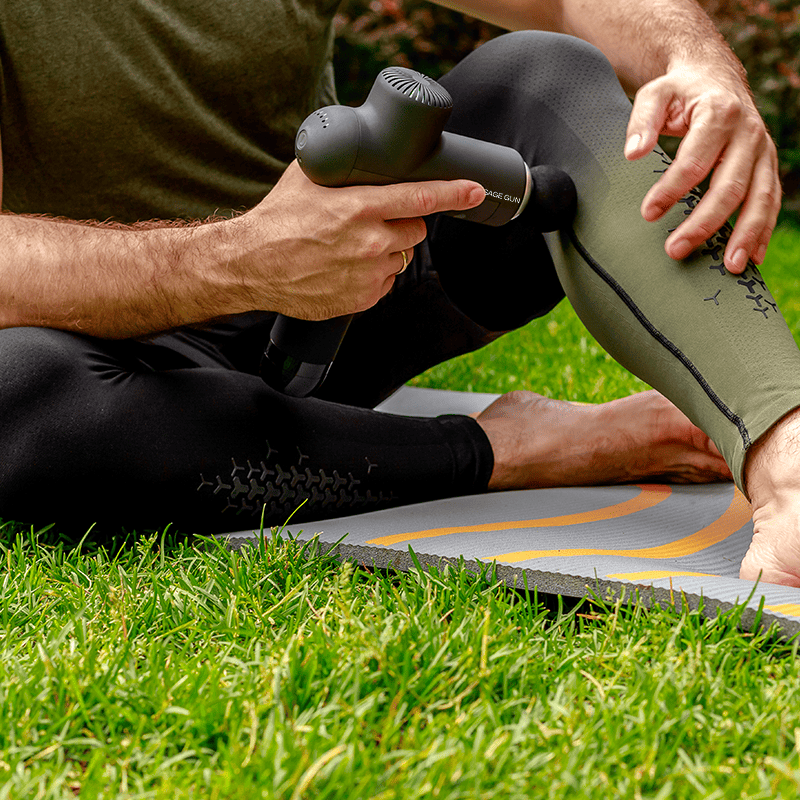A massage gun is an effective device that can improve physical activity recovery, reduce muscle pain, and enhance overall health. It uses percussion therapy to deliver deep vibrations into the muscle fibers, improving circulation and promoting myofascial release.
Knowing when to use a massage gun, how to use it safely, and understanding its various benefits can help you maximize your workout recovery routine.
Understanding the benefits of using a massage gun
Massage guns offer numerous benefits, from improving blood circulation to reducing muscle tightness. They help increase blood flow and break down fascia by delivering rapid percussive movements to the muscles.
These vibrations penetrate deep into the soft tissue, enhancing flexibility, releasing muscle knots, and promoting overall muscle strength.
Regular use of a percussion massage gun also helps alleviate inflammation and muscle fatigue, making it an excellent option for both casual users and professional athletes.
When to use a massage gun: before a workout?

Using a massage gun before a workout helps to warm up the muscles, preparing them for physical exertion by increasing blood flow and improving muscle movement. This pre-workout routine can reduce the risk of injury by enhancing flexibility and releasing tightness in the connective tissue and muscles.
Spend about 3-5 minutes on each muscle group like the quads, hamstrings, and calves to ensure the muscles are fully activated. For athletes, this pre-workout use helps improve endurance and strength during the actual training session.
One benefit often overlooked is that massage guns can help with neural activation, stimulating the muscles and improving reaction time for sports requiring quick responses. This added advantage makes it a valuable tool for athletic preparation.
Using a massage gun after a workout
A massage gun is incredibly effective for post-workout recovery. After intense physical activity, muscles can become tight and sore due to the buildup of lactic acid and fatigue.
By using a massage gun for 5-10 minutes on each muscle group, you help reduce this tightness, prevent delayed onset muscle soreness (DOMS), and promote muscle recovery. Percussive treatment helps to relieve muscle tension and improve blood flow, which speeds up recovery and reduces inflammation.
Using a percussive massage gun post-workout helps release soft tissue and aids in myofascial release, which is key to avoiding prolonged muscle soreness. Many studies, including those in the International Journal of Sports Medicine, confirm the positive effects of massage guns on muscle recovery.
Using a massage gun during rest days

Incorporating a massage gun on rest days is another way to maintain muscle health. During rest, muscles repair and rebuild, and using the gun at a low speed can aid in lymphatic drainage, removing toxins and promoting overall muscle recovery.
By gently applying the gun, you stimulate blood vessels and blood circulation, which helps prevent muscle stiffness. Regular use during rest days can enhance your mobility and reduce the chances of muscle knots forming, even on days when you're not working out.
How to use a massage gun for injury recovery?

Massage guns are not only for workouts they can also be used for rehabilitation. For minor injuries like muscle strains or soft tissue damage, the vibration therapy from a massage gun helps to increase blood flow, delivering essential nutrients and oxygen to the injured area.
This promotes faster healing and reduces inflammation. However, it’s important to use the gun on a lower setting and avoid direct use on bones or joints. Always consult a healthcare provider or physical therapist before using a massage gun for more severe injuries.
When not to use a massage gun?
There are specific instances when it’s not safe to use a massage gun. Avoid using it on areas with open wounds, blood clots, or varicose veins, as this can lead to complications. People who are on blood thinners or have conditions like deep vein thrombosis should refrain from using a massage gun without medical advice.
Additionally, avoid using the gun on bony areas like the spine or joints, as the pressure could cause injury. If you’re unsure, consult with a board-certified medical professional or DPT.
Massage gun safety tips
To safely use a massage gun, start with a low speed setting, especially if you're new to using one. Gradually increase the intensity as your muscles adapt. Focus on muscle groups rather than bony areas, and always move the gun in slow, sweeping motions to avoid overstimulation.
Different attachments offer different levels of pressure, so be sure to use the appropriate attachment for each target muscle. For example, the flat head works well on larger muscles like the quads, while the bullet head is ideal for precise areas like the calves.
Combining massage gun therapy with other recovery tools
For optimal recovery, consider combining percussive massage treatment with other methods such as foam rolling or deep tissue massage. Using a massage gun before or after foam rolling can improve muscle flexibility and further reduce soreness.
The benefits of massage guns extend to improving muscle pliability, making other recovery methods more effective. You can also integrate the gun into stretching routines, enhancing overall mobility and range of motion.
How often should you use a massage gun?

The frequency of massage gun use depends on your individual needs and workout routine. For most people, 3-4 times per week is ideal for maintaining muscle mass and preventing soreness. On intense training days, you may want to use the gun both before and after the workout to maximize recovery.
Using the gun on rest days, as previously mentioned, can help relieve tension and reduce inflammation. Remember to always listen to your body and adjust your usage accordingly.
Can massage guns aid in weight loss?

While massage guns don’t directly contribute to weight loss, they can help you stay consistent with your fitness goals by reducing muscle fatigue and soreness.
By allowing you to maintain a more rigorous training schedule, they help support the muscle recovery process, indirectly contributing to improved performance and better fitness outcomes.
Additionally, massage guns improve circulation and help with the removal of excess fluid, making you feel lighter and more energetic after use.
Frequently asked questions

1. When should I use a massage gun?
You should use a massage gun before a workout to prepare the body by warming up tight muscles, after exercise to promote pain relief and recovery, or on rest days to reduce stiffness and maintain muscle flexibility. Percussive therapy helps increase blood flow, break down scar tissue, and decrease the risk of injury.
For athletic performance, it’s recommended to use the gun for about 3-5 minutes pre-workout to improve movement and 5-10 minutes post-workout for faster recovery of sore muscles.
2. Is it better to use a massage gun before or after a workout?
Using a massage gun both before and after a workout provides multiple benefits. Pre-workout, it helps loosen tight muscles, stimulate blood flow, and reduce the risk of injury by preparing the human body for physical activity.
Post-workout, it aids in pain relief, reduced muscle soreness, and faster recovery by breaking down lactic acid and promoting healing. Studies, including those published in the Journal of Sports Physical Therapy, recommend using the gun for a few minutes before and after exercise for optimal results.
3. How often should I use a massage gun?
You can safely use a handheld massager 3-4 times per week depending on your fitness routine and the condition of your muscles. Daily use of a massage gun is possible, but always listen to your body and adjust usage based on how your muscles feel.
For intense athletic activities, using it pre-workout and post-workout helps with both muscle activation and recovery. For lighter recovery days, use it to decrease tension and maintain muscle pliability. Always consult a board certified massage therapist for personalized guidance.
4. Can you use a massage gun every day?
Yes, you can use a massage gun every day, especially if you’re recovering from intense sports physical therapy or athletic training. However, it’s important to avoid overusing it, as too much pressure can aggravate tight muscles.
Use the massage gun safely by focusing on soft tissue and avoiding bones and joints. Shorter sessions of 1-2 minutes per muscle group are recommended for daily use, with longer sessions on rest days to prevent muscle stiffness.
5. What are the benefits of using a massage gun before a workout?
Using a massage gun pre-workout improves mobility, increases blood circulation, and activates the muscles, helping you fit into your workout routine with reduced risk of injury. Percussive therapy also helps relieve stress by relaxing the muscles, making it easier to perform intense physical activities.
According to a systematic review published in the Journal of Sports Physical Therapy, using a massage gun before a workout helps build endurance and improve muscle performance during the session.
6. How long should I use a massage gun?
The recommended usage time for a massage gun is 1-2 minutes per muscle group. Pre-workout, use it for about 3-5 minutes to warm up key muscles, and post-workout, spend 5-10 minutes focusing on sore muscles for pain relief and recovery.
Keep the massager moving to prevent overstimulation of any one area and avoid applying too much pressure, especially on bones or sensitive areas like the skin.
7. Is it safe to use a massage gun after every workout?
It’s generally safe to use a massage gun after every workout, especially when done properly. Percussive therapy helps reduce muscle stiffness, improve blood flow, and deliver nutrients to the muscles, promoting faster recovery.
Using the gun after a workout also helps reduce muscle soreness and build flexibility by targeting soft tissue and breaking down scar tissue. Be sure to follow a guide for proper use, focusing on muscle areas rather than joints or bones to avoid injury.
8. Can you use a massage gun for injury recovery?
A massage gun can be a useful tool for injury recovery, especially for treating soft tissue injuries or tight muscles. By improving blood circulation and reducing inflammation, the gun helps speed up healing.
It’s important to use moderate pressure and avoid applying the gun directly to the injured area. Always consult a massage therapist or healthcare provider before using a massage gun for injury recovery to ensure it’s appropriate for your specific condition.
9. When should you not use a massage gun?
Avoid using a massage gun on open wounds, varicose veins, or if you’re taking blood thinners. Additionally, people with osteoporosis, deep vein thrombosis, or joint issues should consult with a board certified medical professional before using the gun.
Never use a massage gun on bones, joints, or inflamed areas. If you're unsure about safe usage, a systematic review of your medical history or consultation with a professional massage therapist is advised.
10. What are the benefits of using a massage gun on rest days?
Using a massage gun on rest days helps maintain muscle pliability and relieve tightness by delivering percussive therapy to the muscles.
This aids in myofascial release, helps with fluid drainage, and reduces stress on your muscles. Regular use on rest days prevents stiffness and keeps your muscles loose for future workouts.
Many studies, such as those in the International Journal of Sports Medicine, show that using a massage gun on rest days enhances overall muscle recovery and sleep quality by reducing tension and promoting relaxation.




